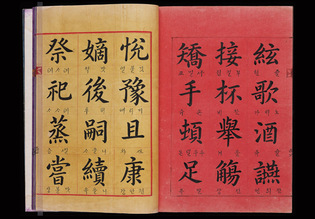 loading
loading
Arts & CultureParsing the moonObject lesson: China’s “alphabet song.” Raymond Clemens is the curator of early books and manuscripts at the Beinecke Rare Book and Manuscript Library.  Beinecke LibraryThe Thousand Character Classic is an ancient poem that has helped generations of students to learn Chinese characters. It was memorized, sung, and relied on much as English speakers rely on the alphabet. This page is from eighteenth- or nineteenth-century Korea, but today you can buy a mass-produced copy, including an English translation, on Amazon. View full imageSometime in the sixth century, a teaching aid was created to help beginners learn to write basic Chinese. It was called the Thousand Character Classic, and it would last for far more than a thousand years. Indeed, it is still used today. The Classic was attributed to Zhou Xingsi (468–521), about whom little else is known. It is a poem featuring exactly a thousand Chinese characters: there are 250 lines of four characters each, grouped into rhyming couplets. Students memorized the characters, always in the same order. For ease of memorization, the poet emphasized rhyme and took care not to repeat characters—though he paid less attention, it seems, to the verse’s meaning. For example, the first two lines, as translated by Nathan Sturman, are as follows:
By the time of the Song Dynasty (960–1279), the Thousand Character Classic had became so ubiquitous that filing systems were developed based on the order of the characters—much as we file items alphabetically. To further aid memorization, the poem was sung aloud, much like the alphabet song. The Classic was used in Korea, Japan, and Manchuria, as well as China. The copy pictured here dates from Korea’s late Joseon period, of the eighteenth to nineteenth century; the meaning and pronunciation of each Chinese character are written beneath it in Korean. The grid layout, the dramatic calligraphy, and the brightly colored paper—blue, violet, and sky blue, as well as red and yellow—would have made learning the characters more pleasant, and would also have helped with memorization. Korea, of course, had its own language and its own phonetic character set (Hangul, created by King Sejong the Great in 1443), but Chinese continued to serve as the lingua franca. Attaining a government job required fluency in written Chinese. This copy of the Classic is one of 44 Korean works that were donated to Yale in 1934 by the Yale Association in Japan, a group of Yale alumni. Asakawa Kan’ichi, a Yale historian and curator of the Yale Library East Asian Collections, advised the group, and the materials were assembled in Japan by the prominent Tokyo University historian Kuroita Katsumi. The great bulk of the collection materials are Japanese, but there are 15 Chinese artifacts in addition to the Korean works. Very much a beginner’s manual, the Thousand Character Classic was normally used by children—who used and reused it until it was in tatters. This copy, with its beautiful calligraphy and stunning paper in near-mint condition, must have been created for another use. Perhaps it was prepared for a member of the aristocracy or a wealthy businessman.
The comment period has expired.
|
|